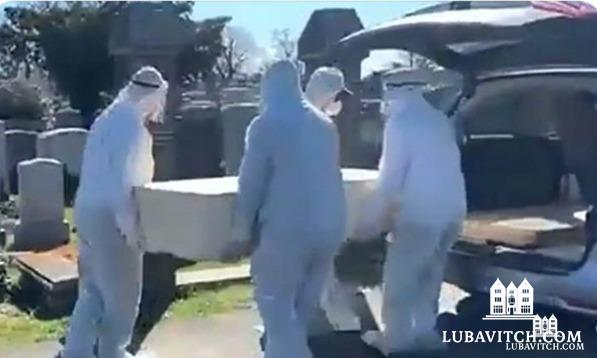In this multimedia mini-series, we look at Chabad’s response to the effects of the coronavirus pandemic on Jewish life events. As people die and are buried with no family to see them off, part four examines how CDC protocol is causing Judaism’s sacred burial societies, to dramatically alter traditional practice.
CDC protocol and funeral home policies are causing Chevra Kadishas, Judaism’s sacred burial societies, to dramatically alter traditional practices. According to updated guidelines by the National Association of Chevra Kadisha (NASCK), the process of “tahara,” in which the body is respectfully washed and sheathed in shrouds has been amended. In the interest of public health, funeral homes are no longer allowing shmira, the vigil over the deceased from death to burial. Only the closest mourners are permitted to attend the quick graveside services. No one enters the chapel anymore.
In his role as Chabad representative to Oceanside, Long Island and as a member of the Chevra Kadisha for more than two decades, Rabbi Levi Gurkov has overseen more than his fair share of funerals. Current services, he says, are mere shadows of those performed just a few short weeks ago. Now Gurkov arrives at a plot with a box of sterile gloves along with his prayerbook. Cemeteries no longer offer shovels to cover the coffin and undertakers don’t want to come close to the mourners. “It’s an eerie feeling,” he says. “No one is allowed to embrace or pay respects up close.
“But the same Torah that instructs us to give proper respect to the deceased, also commands us to go to every length to protect our health and lives,” Gurkov tells mourners who balk at these new restrictions. “It’s very different,” he concedes, “it’s very difficult.”
The challenges begin before death as patients in many hospitals die alone, as next of kin are not allowed to be with them for fear of contagion. Gurkov hasn’t been able to attend to his typical duties as a chaplain at Mount Sinai South Nassau. No one deemed non-essential is permitted inside the hospital, and Shema and the traditional Vidui confession are considered inessential at this time. Nurses and doctors have been using their own phones to call family and chaplains during a patient’s last moments. Gurkov has said the bedside prayers with individuals or forwarded the text to relatives who are able to communicate on Facetime with their loved one.
At a funeral led by Rabbi Sholom Ber Shmerling at Jerusalem Gardens in Venice, Florida this week, a minyan gathered, spread apart as per social distancing guidelines. Dozens more signed on to participate via Zoom video conferencing. Schmerling held a laptop aloft as relatives and friends from around the world shared eulogies. Upon returning home, mourners have their first meal, an egg and bagel, symbolizing the circle of life, alone. Shiva visits are conducted through technology, shiva homes are strictly isolationist today.
The mourners themselves are giving up a pivotal part of the grieving process, but the volunteers who prepare the dead for burial, the Chevra Kadisha members, are paying a high price as well. “It’s the ultimate act of self-sacrifice and kindness,” Schmerling says. “These days,” agrees Gurkov back in New York, “they’re not only giving up their time, they’re exposing themselves to real danger.”
Volunteers are strictly garbed in hazmat suits from head to toe. In their special masks, gloves, and gowns, the assistants are reminded to work quickly, keep their distance from each other, and to remain cognizant of the holiness of their work.
“We’ve lost some of that holy moment for now,” laments Gurkov. “Our Chabad Houses that are always open, are now closed and we can’t even offer a minyan for Kaddish. It’s very painful for all of us.”

Be the first to write a comment.